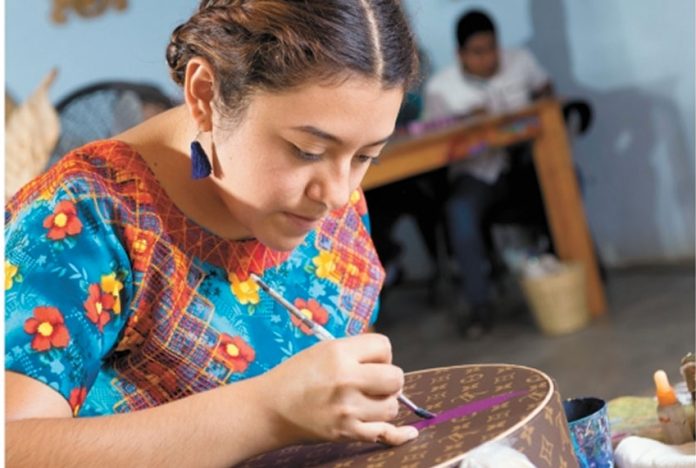A collection of travel trunks recently unveiled by famed French designer Louis Vuitton bear the distinctly fanciful imagery of artisans from Oaxaca communities.
For the collection, displayed during the Zona Maco art-and-design 2020 event in Mexico City, Vuitton engaged painters from the small town of San Martín Tilcajete to intervene by illustrating likenesses of the state’s signature animal figurines upon them.
Entitled The Colorful Journey LV, it included six trunks with different designs and a similarly decorated image of a classic VW Beetle. The purpose was to introduce a new line of products combining the French house’s well-known product with Mexican creativity, combining “the heritage and craftsmanship of two cultures,” according to a press release.
Louis Vuitton hired Natalia Herrera, director of Atelier Cultural in Mexico, to curate the project. Herrera states that she chose the studio due to its work and the social and economic impact the project can have on its young painters.
Waldo Hernández, the director of Taller Casa Don Juan, stated, “We are happy to participate in this venture. Not only has it been a great challenge to work with the materials, but … it is also an important opportunity to show the world our work. Emigration has diminished in our community thanks to projects like these …”
Because of the extreme detail involved in depicting the figures, each case takes about a month to paint.
Although there have been problems in recent years associated with the use of elements from traditional Mexican handcrafts and folk art by different designers, Vuitton assures that the artists’ collaboration will fall under “fair trade” and will follow Mexican law.
In a press release the company said, “Clients will work directly with craftsmen from Taller Casa Don Juan’s workshop …” under the project name of “Los Maestros Artesanos de Oaxaca de Juárez” (Master Craftsmen from Oaxaca de Juárez). “This project has been created under the highest parameters of respect and good practices in the federal copyright laws and the law for safeguarding knowledge, identity and culture of indigenous communities.”
Meanwhile, another workshop in Tilcajete put out a statement disassociating themselves from the collaboration. According to a statement issued on February 8 by artisans Jacobo and María Ángeles, “some people have confused the decoration used in these pieces with our work, [due to] a regrettable ‘coincidence’ [their quotes] in the use of patterns, colors and figures of our workshop published on their social media.”
Although the workshop stated that they do not hold Louis Vuitton responsible for the similarity, and are not opposed to collaborations in their community, they nonetheless asserted, “It is the responsibility of legal experts to analyze if there is a violation of any law related to copyright or intellectual property …”
The statement was covered on February 9 by the magazine México Desconocido, which questioned the appropriateness of the project, referring to past problems with designer Carolina Herrera and with Vuitton himself last year.
Louis Vuitton was questioned by the Secretariat of Culture of Mexico in July 2019, when embroidery on chairs by the designer bore a resemblance to patterns from Tenango de Doria, Hidalgo. The secretariat wanted to know if the company had an arrangement with artisans there, and although Vuitton stated that that was the case, the chairs were taken off the market anyway.
México Desconocido also covered a response by Casa Don Juan, which begins, “We do not plagiarize. We inherit!”
“You argue that our works look similar. … In effect, everyone in the town makes these rabbits, coyotes, jaguars and serpents because they are our animals. Who did it first? This we would have to ask our parents and grandparents.”
Although the Mexican press is calling the figures “alebrijes,” which is the more commonly used name, Louis Vuitton has opted to call them “tonas” and “nahuals,” explaining that they “… are the combination of two powerful animals connected to the day and year in which a person is born.”
Source: El Universal (sp)
